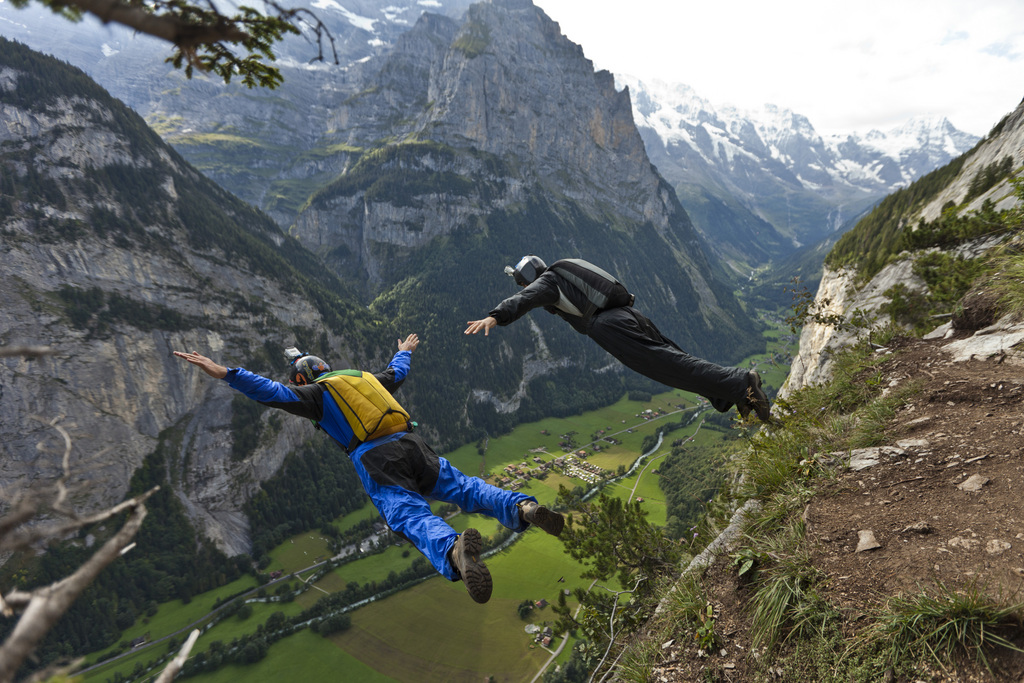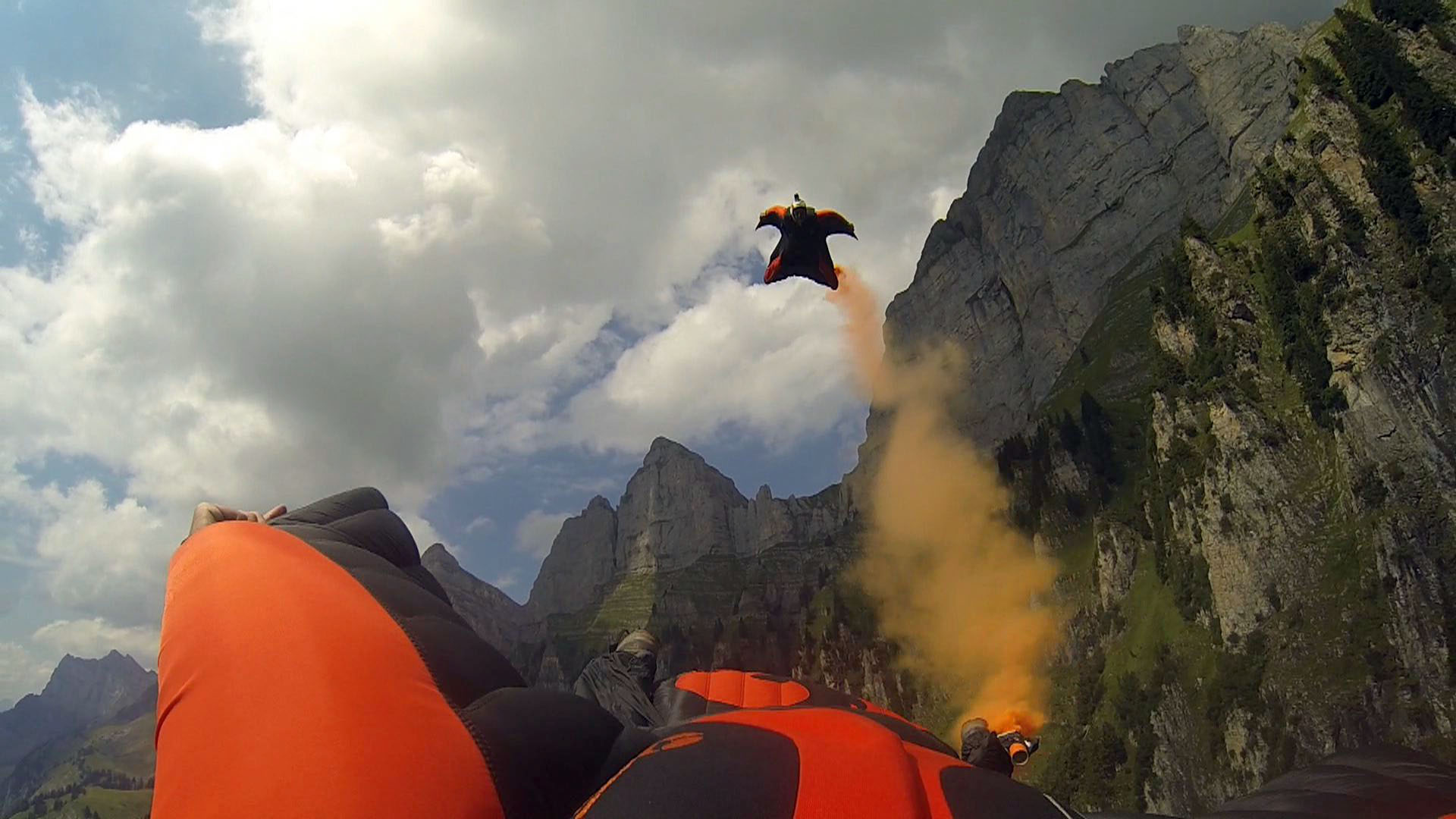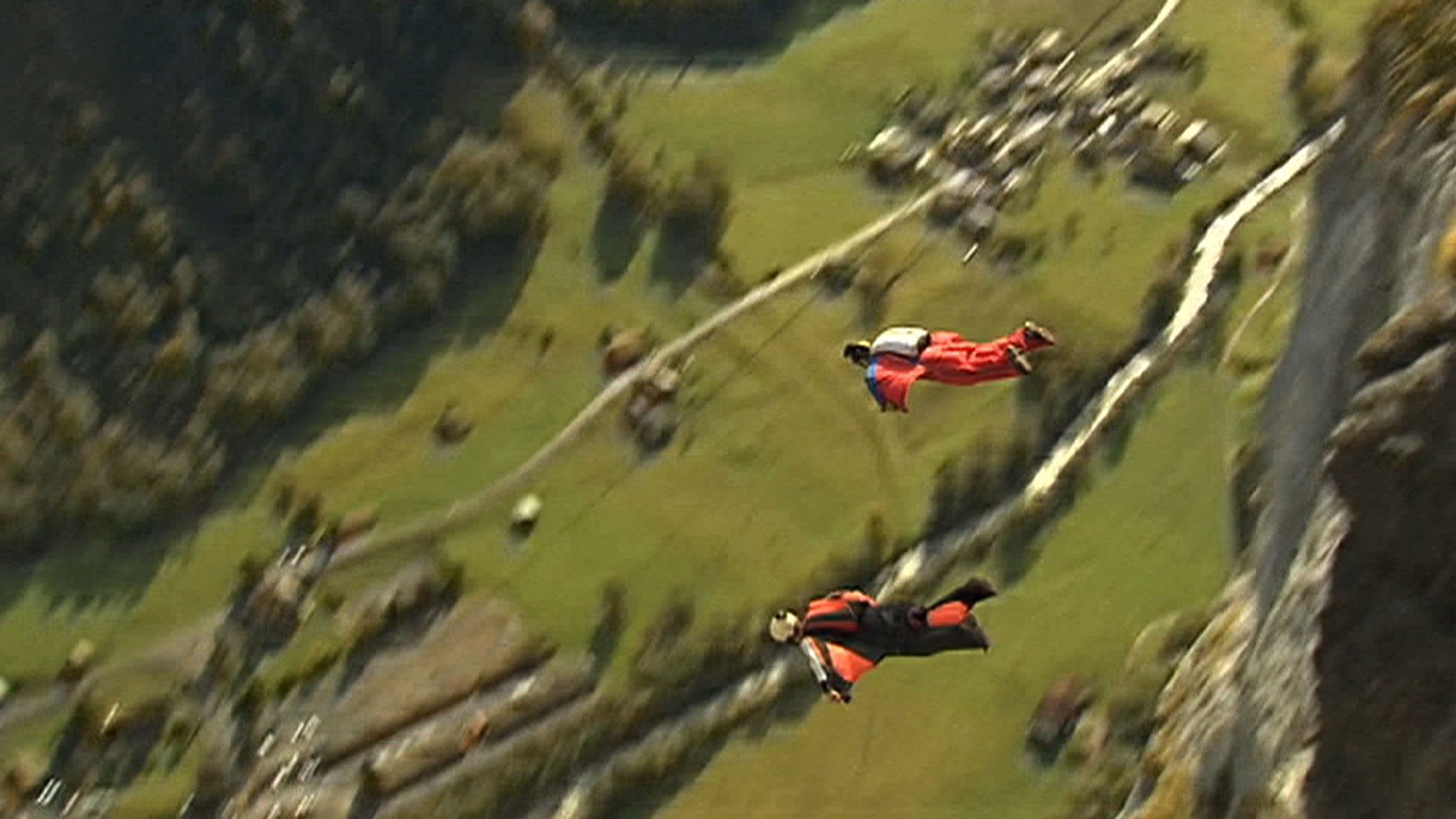The men who jump off Swiss cliffs

What makes people risk their lives jumping off tall cliffs? swissinfo.ch goes to the cliff's edge with the elite – and relative newcomers – to find out if they know their limits to the "dark side of the sport".
The tall orange-and-black bat-like figure shuffles to the edge of the cliff.
Perched on the grassy precipice high above Lake Walensee in eastern Switzerland, Michael ‘Michi’ Schwery goes through some last-minute rehearsals. He switches his two GoPro helmet cameras on, flaps the wings of his suit, and practices reaching behind his back for his parachute release.
“Three, two, one…see ya!”
Suddenly he is gone, leaping off the cliff with arms outstretched, plummeting into the void.
One moment we are laughing and joking on the 2,300-metre-high Hinterrugg peak. The next I’m alone.
Squinting hard I nervously scan the valley below, but there is no sight of him. I daren’t look too far over the edge. My heart is pounding.
Eventually I spot a tiny winged figure speeding into the distance at what I learn is 200km per hour, hugging the mountain contours north of Walenstadt. Then, one minute after leaping off the mountain, he pulls his canopy and floats down safely into a farmer’s field. I breathe a sigh of relief.

More
Basejumping above Walensee in eastern Switzerland
Michi, president of the Swiss Base Association, has just completed ‘Sputnik’. The jump gained global notoriety following a 2011 Youtube video “Grinding the Crack” by base-jumper Jeb Corliss, which was viewed by over 24 million people.
Winging it
Since its early development in the 1990s, wingsuit flying – using special all-in-one webbed aerodynamic suits – has transformed base jumping. It’s the sport in which you leap from a fixed object, like a cliff or bridge.
The webbed suits give pilots the lift and drag in the air to adjust their forward speed and fall rate, creating longer, faster, more spectacular descents.
“It’s a lot of fun using your body to fly. You really have a high degree of control over what you are doing,” says Michi, who has 10 years’ experience and 650 jumps under his belt. “But it’s not just about the flight, it’s the hike up to the exit and jumping with friends and the beauty of the whole thing.”
Hold on, but what about the extreme dangers?
“I’m scared before every jump, but not so much that it’s dangerous for me. I need the fear to concentrate,” he explains. “There is a dark side to the sport. We know it’s dangerous, but we focus on respect for the risks and knowing our limits.”
The dangerous thing in wingsuit flying is when people go too close to the terrain, he adds.
Base jumpers generally start by learning to skydive – the recommended average is 150 dives – before starting to base jump and then possibly moving on to wingsuiting. They either complete a first base jump course such as in the US or find a mentor to help coach them. They start wearing more basic suits and jumping from more simple structures like bridges.
Wingsuits are much more complicated to fly. Regulations by skydiving associations on making a first wingsuit jump vary from country to country. It is generally said you need to do around 200–500 jumps to safely fly a wingsuit.
According to a 2007 study by researchers from Stavanger University Hospital in Norway, base jumping appears to have a five to eight times greater risk of injury or death than skydiving.
Their analysis of 20,850 base jumps from the same site on the Kjerag Massif in Norway showed nine fatalities over the 11-year period from 1995 to 2005, or 1 in every 2,317 jumps, and 82 non-fatal accidents, or one in every 254 jumps.
Worldwide, around 210 base jumping deaths have been recorded since 1981.
Statistics on accidents in the Lauterbrunnen valley collected by Dr Bruno Durrer since 1994 show 35 deaths (33 men and two women) and around 200 injuries, of which 70 involved broken bones and 20 emergency hospitalizations. Since 2006 the annual number of jumps there has risen steeply to 15,000, while the accident statistics have remained stable: 16-24 injuries and 3-5 fatalities a year.
Elite flyers
Base jumping is considered much riskier than skydiving: there is a five to eight times greater chance of injury or death, according to 2007 research.
Flying too close to the mountain and miscalculating the gradient is thought to have cost Mark Sutton his life. On August 14 the 42-year-old London Olympics stuntman died in a wingsuit accident when he hit a ridge in the Grand-Otannes region in canton Valais near Mont Blanc after jumping from a helicopter.
Michi, who is a partner in a Basel engineering firm and married with a young child, is one of 20 elite Swiss wingsuiters who leap off mountains most weekends, pursuing their passion for human flight and new sensations.
And almost every week new jumps are opened in Switzerland – there are now about 50 spots. But, apart from Lauterbrunnen and Walensee, most of the others are well-kept secrets among local enthusiasts, or extreme jumps.
Michi’s friend Patrick Kerber last month ‘opened’ a new jump spot when he wingsuited off the snowy Jungfrau peak, landing 3,000m below in Lauterbrunnen.
Lauterbrunnen – busy place for ‘tourists’
Like hundreds of others, Michi perfected his base jumping skills on the high cliffs of Lauterbrunnen, which has turned into a base ‘Mecca’. But he prefers not to fly there anymore.
“It’s for tourists,” he says. “It’s boring and not a good place for wingsuiting as the cliffs are not that high.”
An estimated 15,000 base jumps are made in Lauterbrunnen every year – a steep rise since 2006. Between April and September, young mostly male jumpers from around the world make a beeline to the central Swiss valley to build up experience and attempt world-famous jumps.
The spectacular steep-sided valley near the Eiger and Jungfrau mountains offers easy access to exit points and fairly consistent weather, allowing jumpers to repeat jumps frequently.

More
Lone farmer opposes deadly sport
Global pull
At the Stechelberg car park at one end of the valley, groups of tourists queue to take the cable car up to the resort of Mürren and onwards to the top of the 2,970m Schilthorn.
Overhead, paragliders swing gracefully to land, and every so often base jumpers leap off the ‘Via Ferrata’ exit and parachute into view near the spectacular Mürrenbach waterfall.
At the far end of the car park, in front of British and German camper vans, jumpers meticulously pack their chutes for their next jump, while others simply hang out, swap stories and watch the action.
The setting is stunning. But unbeknown to me and to probably many of the people there, a well-known Spanish adventurer, TV star and experienced base jumper, Alvaro Bulto, died earlier that morning near Stechelberg when his chute failed to open.
Therapeutic and heart-pumping
“Why do I do it?” asks Barry Holubeck, who has been base jumping for 10 years and skydiving for 18. “It’s a passion for something in life. Personally it’s almost like therapy and meditation. Everyone needs some sort of release.”
Behind his sunglasses he observes the rock above: “It’s an unnecessary risk but knowledge takes the fear away.”
Sean* has been staying in Lauterbrunnen for two months to perfect his base jumping skills after giving up his job in London.
He bangs on his chest: “Without a doubt it gets the heart elevated and I like that feeling. I like scaring myself. You feel alive. It makes you feel you are doing something with your life instead of the monotony of just work, going home, making dinner, TV, work…”
Learning (too) fast
Twenty-two-year-old ‘Buzz’ is also taking time off from his job as a ski patroller in Mt Hutt, New Zealand, to improve his base jumping skills, with the ultimate aim of getting into wingsuit flying.
“So far I’ve done 215 jumps here in two and a half months,” says the 22-year-old.
“It’s hard to explain the feeling jumping off a cliff and the sensation of floating through the air with the wind in your face and in control of what you are doing,” he says.
He says he often thinks about the dangers but tries to jump in a controlled manner: only in nice weather and within his limits.
“My girlfriend says she’s fine with it, but I guess at the end of the day it’s a risk that not everyone takes.” He hesitates and looks down. “Yeah, I think she’s fine with it.”
Pointing his binoculars at the cliffs, José, a climber from Madrid, is on holiday in Lauterbrunnen to learn. He has made 15 parachute jumps and is eager to get into base jumping.
“At night I dream of base jumping,” he says, adding that he is sure it won’t take him the minimum number of freefall skydives before he makes his first base jump.
Michi scoffs at this attitude: “This is typical of the Youtube generation, who see cool videos and want to get into the sport too quickly. Many people try to do short cuts. That’s another reason why I stay away from Lauterbrunnen. I don’t want to see those people or talk to them.”
*name withheld
Wingsuits are increasingly popular with base jumpers. “Base” stands for four main categories of fixed objects: buildings, antenna, spans (bridges) and earth (cliffs, mountain, etc). Helicopters have also been added to this list.
In recent years, the use of wingsuits has increased as skydivers look to push the limits of the sport.
According to the Guinness Book of World Records, the greatest distance flown in a wingsuit is 17.83 miles, achieved in May 2012 by Japan’s Shinichi Ito above Yolo County in California.
The longest duration of flight is nine minutes and six seconds, by Jhonathan Florez from Colombia, above La Guajira in Colombia in April 2012.
In early May the Russian extreme sports star Valery Rozov, 48, leapt from an altitude of 7,220m off the north side of Everest.

In compliance with the JTI standards
More: SWI swissinfo.ch certified by the Journalism Trust Initiative

You can find an overview of ongoing debates with our journalists here. Please join us!
If you want to start a conversation about a topic raised in this article or want to report factual errors, email us at english@swissinfo.ch.